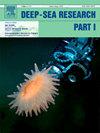南海东北部浮游有孔虫壳原位Mg/Ca比值:一种有效可靠的代用指标的尝试
IF 2.1
3区 地球科学
Q2 OCEANOGRAPHY
Deep-Sea Research Part I-Oceanographic Research Papers
Pub Date : 2025-07-03
DOI:10.1016/j.dsr.2025.104553
引用次数: 0
摘要
浮游有孔虫是物化环境的重要载体之一。原位微量分析技术的最新进展为有孔虫个体壳中微量元素浓度的空间分布和变化提供了新的认识。本文研究了南海东北坡表层沉积物中生活在不同深度的4种浮游有孔虫的原位Mg/Ca比值变化。电子探针图谱和LA-ICP-MS结果表明,Globigerinoides橡胶中存在高Mg含量和高Mg/Ca比值的周期性条带,这可能是共生菌的结果。相比之下,Neogloboquadrina dutrei, Pulleniatina obliquiloculata和Globorotalia inflata表现出较厚的方解石层,Mg/Ca比较低,可能与方解石结壳有关。同时,较高的Mg/Ca比值可能与污染物有关,特别是壳表面的污染物。这些结果表明,有孔虫壳中Mg/Ca比值的变化不仅受周围海水温度的控制,还受其他因素的影响。利用这种方法,我们重建了过去~ 3000年来东北南海的Mg/Ca-SST。结果表明,重建的海温趋势与以前的区域记录一致,验证了方法的鲁棒性。该方法具有效率高、处理速度快、空间分辨率高、样本量少等优点,有望在未来得到广泛应用。本文章由计算机程序翻译,如有差异,请以英文原文为准。
The in situ Mg/Ca ratios of planktonic foraminifera shells in the northeastern South China Sea: an attempt to get efficient and reliable proxies
Planktonic foraminifera are one of the important carriers of the physico-chemical environments. Recent advances in in situ microanalysis techniques provide new insights into the spatial distribution and variations of trace element concentrations of individual foraminifera shells. In this study, we focus on the variations of the in situ Mg/Ca ratios of four planktonic foraminifera species, which live in the different depths, from the surface sediments of the northeastern slope of the South China Sea (SCS). Both electron microprobe mapping and LA-ICP-MS results indicate that Globigerinoides ruber exhibits periodic bands with high Mg contents and Mg/Ca ratios, which may be attributed to symbionts. In contrast, Neogloboquadrina dutertrei, Pulleniatina obliquiloculata, and Globorotalia inflata exhibit thick calcite layers with low Mg/Ca ratios, potentially associated with calcite crusts. Meanwhile, high Mg/Ca ratios may be attributed to the contaminants, especially on the shell surface. These findings demonstrate that the variations of Mg/Ca ratios in foraminifera shells are controlled not only by the surrounding seawater temperature but also by other factors.
Applying this method, we reconstructed Mg/Ca-SST in the northeastern SCS over the past ∼3000 years. The results indicate that the reconstructed SST trend aligns with the previous regional records, which validates the robustness of the method. We hope that this method can be widely applied in the future due to the efficiency, rapid processing, and high spatial resolution with minimal sample requirements.
求助全文
通过发布文献求助,成功后即可免费获取论文全文。
去求助
来源期刊
CiteScore
4.60
自引率
4.20%
发文量
144
审稿时长
18.3 weeks
期刊介绍:
Deep-Sea Research Part I: Oceanographic Research Papers is devoted to the publication of the results of original scientific research, including theoretical work of evident oceanographic applicability; and the solution of instrumental or methodological problems with evidence of successful use. The journal is distinguished by its interdisciplinary nature and its breadth, covering the geological, physical, chemical and biological aspects of the ocean and its boundaries with the sea floor and the atmosphere. In addition to regular "Research Papers" and "Instruments and Methods" papers, briefer communications may be published as "Notes". Supplemental matter, such as extensive data tables or graphs and multimedia content, may be published as electronic appendices.

 求助内容:
求助内容: 应助结果提醒方式:
应助结果提醒方式:


